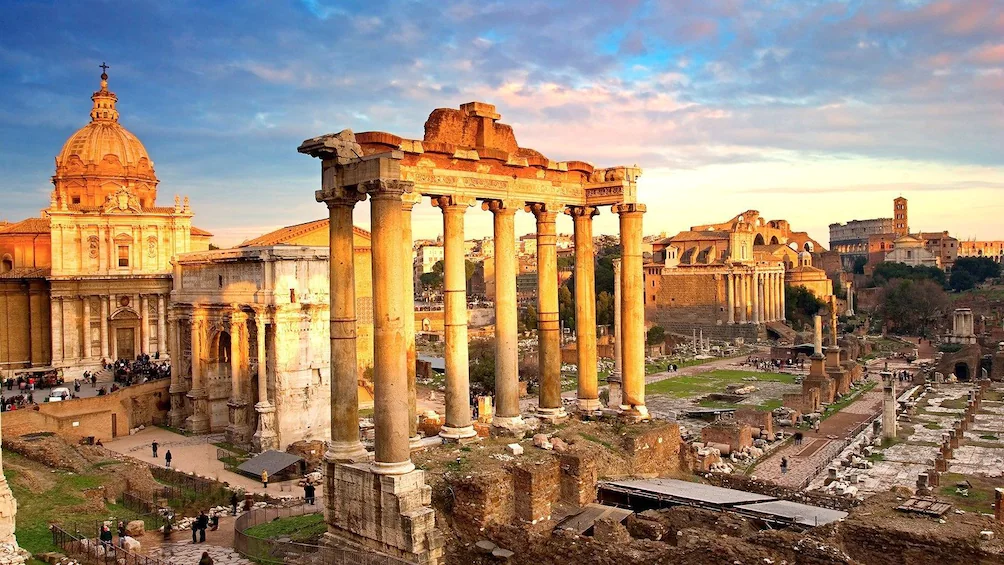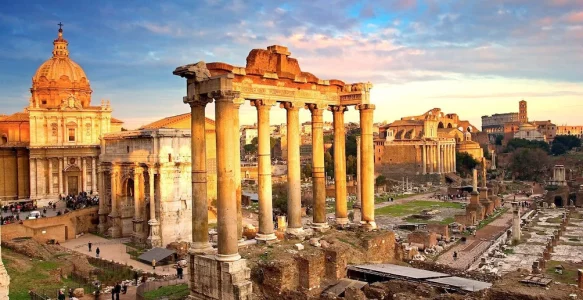Lucy Chen
The Forum Romanum (or Roman Forum) is a critical part of the City of Ancient Rome. Many important events and activities were done here, such as public meetings, law courts, and gladiatorial combats (Roman Forum). Under the Empire, many of the city’s most majestic temples and monuments were built, and they were largely used as a center for religious and secular shows and rituals.
The Forum Romanum is located “between the Capitoline and Palatine Hills of Rome” (Cartwright). From the 11th century BC to the 9th century BC, this region was “filled in with a significant quantity of earth and rubble fill to raise it above the level of the River Tiber’s annual flood” (Cartwright). It was then paved from the 8th century BC to the 7th century BC. The Roman Forum, also known as the Roman Market, was officially built in the 6th century B.C. With gradual development, the Forum became an essential part of society, “and the architecture became more imposing and ceremonial in function”(Cartwright). The forum was the center of the city during the Roman era and includes some of the oldest and most important buildings in Rome. As the Roman Empire grew stronger it was constantly expanded and renovated until the 4th century. The massive construction stopped, after the square of the Roman Forum was devastated by years of wars, earthquakes, and fires in 283 AD. Because of the need for much rebuilding and restoration, “the Forum eventually fell into decline, even if it was occasionally used for ceremonial purposes” (Cartwright). In 330 AD, the Roman Empire officially moved its capital to Constantinople.
There are many architectures for various purposes located in the Forum Romanum. One of the most important is the Temple of Vesta. This temple holds Vesta’s sacred fire that symbolizes Rome’s safety and prosperity”, and the Palladium, “an effigy of Athenebelieved to have been brought by Aeneas from Troy” (Temple of Vesta). However, since the Temple of Vesta was not inaugurated, nor did it contain an image of Vesta—the goddess of the household hearth—it cannot count as a true temple. Near the Temple of Vesta is the House of Vestals. There were 16 vestal virgins in total and their primary duty was to protect the sacred fire and never let it be extinguished. Vestal Virgins were only chosen from children from upper-class families at the age of 6 or 7. “Each vestal virgin‘s time in the cult lasted thirty years”, and every year they will change their duties. For example, “the first ten years were to learn the ways of the college, with the next ten years performing the rituals of the house and finally, their last ten years were to train the new virgins” (Goodge). Being a Vestal Virgin also has many privileges. As the most influential women in Rome, they had “extremely higher rights compared to the common women” (Goodge). They were the only women who were able to vote and voice their political opinion on matters, own property, had freedom from their fathers/husbands, and attend events that were only for men(Goodge). However, the Vestal Virgins also got harsh punishment when they violate rules. “If a virgin broke their celibacy vows, they would have disastrous repercussions, punishable by death by whipping or being buried alive in the underground chambers” (Goodge). In 191 AD, the temple caught on fire; “today only the base and a short elevation of reconstructed travertine blocks survive” (Cartwright).
In addition, the Temple of Apollo was also an important part of the Forum Romanum. The temple of Apollo at the Roman Forum was built in 120 BC and was the first temple that was dedicated to the God of the sun, Apollo. Influenced by Greek Culture, the cult of Apollo became widespread in other European countries, including Campania. There was another temple that was also dedicated to Apollo by Augustus at Paletinus, which later became the most famous temple of Apollo in Rome (Temple of Apollo).
Another temple was dedicated to another Roman God of sowing, Saturn. Saturn was a “somewhat mysterious god in the Roman pantheon who was perhaps a version of the Greek Kronos” (Cartwright). The Saturnalia festival was an event that was specifically for Saturn; “it holds every 17th of December from at least the 5th century BCE” (Cartwright). The Temple of Saturn is rectangular, and “stands on a pediment of travertine blocks while the eight remaining columns are of the Ionic order. The shafts of the columns were made from Egyptian granite, the two on the side from pink Aswan, and the six facade ones from grey Mons Claudianus. The Ionic capitals were, in fact, the only parts made specifically for the temple. Within the temple once stood a cult statue of Saturn” (Cartwright). The Temple of Saturn was eventually destroyed by the fire of 283 AD and was reconstructed in the 4th century AD ((Knowlton). Today, part of the Temple of Saturn is still standing.
Other than these architectures mentioned, the Roman Forum still has much more to explore such as the Temple of Castor and Pollux, Arch of Septimius Severus, and the Curia. Even though these important architectures were partially destroyed for various reasons, the culture of Ancient Rome will continue to last.
Works Cited
Cartwright, Mark. “Roman Forum.” World History Encyclopedia, World History Encyclopedia, 11 Oct. 2018, www.worldhistory.org/Roman_Forum/. Accessed 27 Apr. 2022.
Goodge, Cass. “Who Were the Vestal Virgins?” Vatican Tours, Vatican Tours, 6 Dec. 2018, www.vaticancitytours.it/blog/who-were-the-vestal-virgins/. Accessed 27 Apr. 2022.
“Knowlton School Digital LibraryWorkTemple of Saturn, Forum Romanum, Rome, Italy [67331].” Osu.edu, 2022, knowltondl.osu.edu/index.php/Detail/objects/9353. Accessed 27 Apr. 2022.
“Roman Forum | History, Location, Buildings, & Facts | Britannica.” Encyclopædia Britannica, 2022, www.britannica.com/topic/Roman-Forum. Accessed 27 Apr. 2022.
“Temple of Apollo Palatinus.” Virginia.edu, 2022, archive1.village.virginia.edu/spw4s/RomanForum/GoogleEarth/AK_GE/AK_HTML/TS-049.html. Accessed 27 Apr. 2022.
“Temple of Vesta.” Uchicago.edu, 2022, penelope.uchicago.edu/~grout/encyclopaedia_romana/romanforum/vesta.html. Accessed 27 Apr. 2022.



Good post. I definitely appreciate this website. Stick with it!
Good post. I learn something new and challenging on blogs I stumbleupon on a daily basis. Its always exciting to read content from other authors and use a little something from other web sites.
6tnlqx